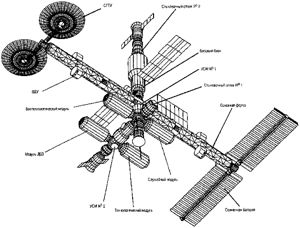
Home - Search - Browse - Alphabetic Index: 0- 1- 2- 3- 4- 5- 6- 7- 8- 9
A- B- C- D- E- F- G- H- I- J- K- L- M- N- O- P- Q- R- S- T- U- V- W- X- Y- Z
Mir-2
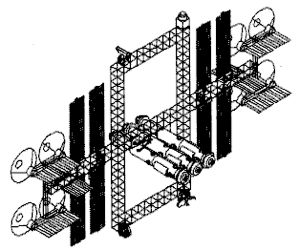 Mir-2 Energia Version of the Mir-2 shown by RKK Energia in 1990 Credit: via Steven S. Pietrobon |
Status: Study 1989. Gross mass: 450,000 kg (990,000 lb).
It would undergo many changes over the year, with only one thing remaining constant: the starting point was always the DOS-8 base block space station core module, built as a back-up to the DOS-7 base block used in the Mir station. Eventually Mir-2 would be merged with the International Space Station, and DOS-8 was finally scheduled to be launched by the end of 2000 as the Service Module of the ISS.
DOS-8 serial number 128 was originally designed to have a three year service life in space. This was later increased to five years. The spaceframe was completed in February 1985 and major internal equipment was installed by October 1986. Until Reagan's 1983 announcement of the Star Wars program, Mir-2 was to be a relatively modest station, a near-duplicate of Mir assembled after the end of its planned five year life.
The decision by Soviet Premier Andropov to compete with America in military dominance from space lead to a huge expansion of Soviet space station plans. Several space battle stations were proposed, and there seems to have been a design competition for a drastically revised Mir-2.
KB Salyut Mir-2
This version of Mir-2 was designed by KB Salyut from 1981 The prototype of the central module was flown six years later as the Polyus star wars test-bed. The overall design of the station was shown by the Soviets in 1987 at the 38th meeting of the IAF in Montreal. Most of the demand for electricity was met by solar panels mounted on a docking tunnel providing 2 degrees of freedom for following the sun. Radiators were mounted in the shadow of the solar cells. Additional electrical power was provided by a solar dynamic system. The concentrator for this was mounted on tracks running around the core's body which allowed the concentrator to follow the sun. Movement of the concentrator's mass would have been offset by movement of the mass of the docking arm.
The docking arm would have been used to move modules from the bay of the Buran shuttle, which could dock at a special adapter mounted on the end of one of the modules. Buran would also have been able to dock at the adapter on the end of the docking tunnel, but it kept that normal operations would have been supported by large ballistic capsules.
These ballistic capsules were 'stretched' versions of the reusable VA capsule designed for the TKS manned station ferry. They were called Orfar by V.V. Pallo of KB Salyut in a description of a commercial derivative of the Polyus called the SKIF-DM. Orfar was the equivalent of the NPO Energia Zarya capsule and would be launched by the Proton launch vehicle.
Only the central core and the solar panels and docking tunnel would have had to have been launched by the Energia booster. All other components could have been launched by the Proton and operation of the KB Salyut Mir 2 space station did not depend upon the success of Energia or Buran. Mir 2 would have been capable of docking at least four modules in ordinary operation.
NPO Energia Mir-2
After the 1983 instruction to significantly expand the Mir-2 design, NPO Energia first added a cross beam to the station like that in American space station designs. This would allow a greatly increased number of solar panels to be installed. This initial configuration was designated OSETS (Orbital Assembly and Operations Centre). As design continued the station grew to immense proportions. The draft project for this greatly expanded station was approved by NPO Energia Chief Semenov on 14 December 1987 and announced to the press as 'Mir-2' in January 1988. The station would be built in a 65 degree orbit and consist mainly of enormous 90 metric ton modules. It would dwarf even the MKBS station planned in the 1960's. The station would be built up according to the following plan:
- Launch 1 - DOS 8 - providing housing for the assembly crew. Boosted into orbit by the Proton launch vehicle.
- Launch 2 - 90 metric ton module launched by the Energia 14A10 version. This added the GTAS Payload Transfer and Supply System tug to the basic Energia configuration. The tug would deliver the module to the station, dock it, then depart and deorbit itself.
- Launch 3 - Truss and solar arrays, launched by Energia.
- Launches 4 to 6 - additional 90 metric ton modules, launched by Energia
As in the KB Salyut version, this station would be visited by Buran but mainly resupplied by ballistic capsules, in this case the Zarya and Progress-M2 spacecraft, boosted by Zenit. Assembly of the station was expected to begin in 1993.
As the Soviet Union disintegrated plans for this station were scaled down. In 1989 further work on the Zarya was stopped. By 1991 the Energia modules were out of the picture and the drastically reduced 'Mir 1.5', was under consideration.
This would involve launch of the DOS-8 by a Proton booster. The separately launched Buran would grapple the module, rendezvous with Mir, and attach it to the old DOS-7 base block. By autumn this plan was again modified to have the DOS-8 maneuver and dock itself to Mir. It would remain attached for two years. During this period Buran would deliver a prototype 37KBT biotechnology module which would prove equipment for commercial production of pharmaceuticals in zero gravity.
DOS-7 would then be deorbited, beginning the start of a four year assembly process of the 'Mir-1.5' station. DOS-8 would be equipped by Buran with 37KBE power modules and two operational 37KBT biotechnology modules. Buran could swap the 37KBT modules and return them to earth for removal of the products produced and outfitting for reuse. Buran would also deliver a long power truss. Assembly was to be completed by 2000.
By 1992 Buran was now out of the picture and the plan was reduced in scale again. These revised plans were approved by the Council of Chief Designers on 24 November 1992. Mir-2 returned to its original planned 65 degree orbit, and would be assembled and flown separately from Mir. It would now consist of the DOS-8 core module, and a cross beam called the NEP (scientific-energy platform). This was equipped with equipment already proven on Mir: MSB retractable solar panels, Sfora thruster packages, small scientific packages as demonstrated on Kvant.
The add-on modules now used the Progress-M service module as a tug, and were reduced in size for launch by either the Soyuz or Zenit launch vehicles. Earth resources had been eliminated as a station activity (presumably Mir work had shown photographing the earth was more practical using free-flying satellites). Instead the four modules would weigh only 3 to 4 metric tons each and consist of:
- Docking Module - with the APDS universal androgynous docking system, and a side hatch for space walks
- Resource Module - Equipped with gyrodynes for orienting the station and a passive docking port for docking of Soyuz or Progress ferry spacecraft
- Technology Module - with materials experiments
- Biotechnology Module
By November 1992 further financial difficulties and uncertainties with America's Freedom space station led Russia and the European Space Agency to open discussions on joint development and use of Mir-2. This circle was expanded in the summer of 1993 when Energia briefed NASA on the Mir-2. Finally in November 1993 Freedom, Mir-2, and the European and Japanese modules were incorporated into a single International Space Station.
At first the ISS would be serviced by the larger Zenit-launched modules. These were soon dropped. Current Russian elements of the ISS include:
- Zarya FGB, the first element launched. This was a US-funded TKS-derived propulsion module built by KB Salyut.
- Service Module - this was the DOS-8 station, finally to be launched as the second major ISS module during 2000.
- NEP - the Russian electrical power crossbeam designed for Mir-2 would be delivered by a shuttle mission in 2001.
- SO-1 - one of the docking modules originally designed for Buran/Mir-2 would be added to the station at some future date.
| USB Russian military anti-satellite system. Study 1978. As platforms for operational versions of space-borne weapons NPO Energia designed a Universal Service Block, based on the DOS-7K space station, in the late 1970's/early 1980's. |
| Mir-2 KB Salyut Russian manned space station. Cancelled 1988. Alternative design for the Mir-2 space station by KB Salyut. If Polyus had successfully made it to orbit, it might have been the core for such a station. |
Family: Soviet Space Stations, Space station, Space station orbit. Country: Russia. Launch Vehicles: Proton, Energia. Agency: Korolev bureau. Bibliography: 474, 6712.
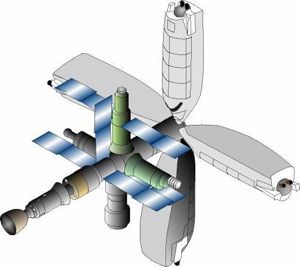 | KS The KS battle station. Stripped surplus Buran test articles are docked to the core. They would act as nuclear weapon dispensers. |
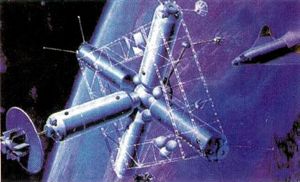 | Mir-2 Concept 1988 The illustration depicts one possible Mir-2 design from the late 1980s. Credit: DoD via Marcus Lindroos |
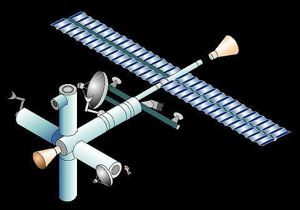 | Mir-2 Khrunichev Credit: NASA |
1976 February 17 - .
- Energia; Buran; Mir; Luch; Potok approved; N1 formally cancelled. - .
Nation: Russia.
Spacecraft: Buran,
Gamma,
Luch,
Mir,
Mir-2,
Potok.
Central Committee of the Communist Party and Council of Soviet Ministers Decree 'On work on Energia-Buran, DOS-7K nos. 7 and 8, Gamma. Geyzer (Potok), and Altair (Luch) and cancellation of the N1' was issued. The design of an improved model of the Salyut DOS-17K space station was authorised as part of the third generation of Soviet space systems in a decree. At that time it was planned that the two stations (DOS-7 and DOS-8) would be equipped with two docking ports at either end of the station and an additional two ports at the sides of the forward small diameter compartment. Luch and Potok were elements of the second generation global command and control system (GKKRS) deployed in the first half of the 1980's. Luch satellites, analogous to the US TDRS, provided communications service to the Mir space station, Buran space shuttle, Soyuz-TM spacecraft, military satellites, and the TsUPK ground control center. They also served to provide mobile fleet communications for the Soviet Navy. Additional Details: here....
1985 February - .
- DOS-8 structure completed. - . Nation: Russia. Spacecraft: ISS, ISS Zvezda, Mir-2. DOS-8 serial number 128 was originally designed as the backup to Mir and possibly the core module of Mir-2..
1986 October - .
- DOS-8 major equipment installation complete. - . Nation: Russia. Spacecraft: ISS, ISS Zvezda, Mir-2. DOS-8 serial number 128 was originally designed as the backup to Mir and possibly the core module of Mir-2..
1987 December 14 - .
- Mir-2 draft project approved - .
Nation: Russia.
Spacecraft: ISS,
ISS Zvezda,
Mir-2.
The draft project for this greatly expanded station was approved by NPO Energia Chief Semenov on 14 December 1987 and announced to the press as 'Mir-2' in January 1988. The station would be built in a 65 degree orbit and consist mainly of enormous 90 tonne modules. But the first launch, as always, was the DOS 8. Assembly of the station was expected to begin in 1993.
1992 November - .
- Mir-2 joint use with ESA discussed - . Nation: Russia. Spacecraft: ESA MTFF-Derived Space Station, Mir-2, Space Station Freedom. Further financial difficulties in Russia and uncertainties with America's Freedom space station led Russia and the European Space Agency to open discussions on joint development and use of Mir-2..
1992 November 24 - .
- Council of Chief Designers review revised Mir-2 design - .
Nation: Russia.
Spacecraft: ISS,
ISS Zvezda,
Mir-2.
With abandonment of the Buran shuttle and 37K modules, the Mir-2 design was cut back again. Mir-2 returned to its original planned 65 degree orbit, and would be assembled and flown separately from Mir. It would now consist of the DOS-8 core module, and a cross beam called the NEP (scientific-energy platform). This was equipped with equipment already proven on Mir: MSB retractable solar panels, Sfora thruster packages, small scientific packages as demonstrated on Kvant.The add-on modules now used the Progress-M service module as a tug, and were reduced in size for launch by either the Soyuz or Zenit launch vehicles.
1993 November - .
- International Space Station - .
Nation: Russia.
Spacecraft: ISS,
Mir-2,
Space Station Freedom.
Cost escalation of the US Space Station Freedom, and financial difficulties in Russia, led to a summer 1993 briefing of NASA by NPO Energia on Mir-2. In November 1993 Freedom, Mir-2, and the European and Japanese modules were incorporated into a single International Space Station.
Back to top of page
Home - Search - Browse - Alphabetic Index: 0- 1- 2- 3- 4- 5- 6- 7- 8- 9
A- B- C- D- E- F- G- H- I- J- K- L- M- N- O- P- Q- R- S- T- U- V- W- X- Y- Z
© 1997-2019 Mark Wade - Contact
© / Conditions for Use
